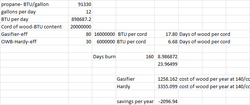heaterman
Minister of Fire
..sounds like a plan. How do you get the stack off to get the creosote out? The darn thing is not insulated and I get a ton of buildup without a double wall. Will the building retain enough heat to solve that problem? They seem to only have single wall and not sure if a double wall connection for the top will adapt as it goes through the roof. Also no sure how to plumb an intake in the back.
Getting the Hardy inside will reduce creosote somewhat simply due to less cooling of the stack. I think you could probably get a single wall x Class A chimney adapter and go up with insulated pipe but you will still get a gob of creosote in the stack. It's just the nature of the beast.
I don't know as I would spend the money on it.
However.....if you do put it inside and run the stack up through the roof, make sure you allow a lot of clearance to combustible materials around it. Keep anything that will burn at least 6" if not more, away from the stack. Reduced clearance would probably be a logical reason to go with a Class A chimney.



